Best Data Extraction Software & Tools
Best data extraction software includes Extract Systems, Simpleindex, Octoparse, Square 9 GlobalCapture, and Visual Web Ripper. These data extraction software automates data collection from various websites and sources and makes it easy to collect, store, retrieve and use These data to research and analyze customers.



No Cost Personal Advisor
List of 20 Best Data Extraction Software
Category Champions | 2024
AI driven web scraping & workflow automation platf
APISCRAPY is an AI-driven web scraping and automation platform that converts any web data into ready-to-use data API. The platform is capable to extract data from websites, process data, automate workflows, classify data, and integrate. Read APISCRAPY Reviews
Explore various APISCRAPY features, compare the pricing plans, and unlock the potential of seamless operations by selecting the right software for your business.
Features
View all APISCRAPY Features- Analytics
- Labeling
- Pricing Extraction
- Web Data Extraction
- Document Extraction
- Data Cleansing
- Image Recognition
- Data Analysis
Pricing
APISCRAPY Caters to
- StartUps
- SMBs
- Agencies
- Enterprises
Category Champions | 2024
All-In-One data crawling and scraping platform for
Save time when developing scrapers and crawlers. Scrape and crawl websites while being anonymous and bypass any restriction, blocks or captchas. The first 1000 requests are free. Read Crawlbase Reviews
Explore various Crawlbase features, compare the pricing plans, and unlock the potential of seamless operations by selecting the right software for your business.
Features
View all Crawlbase Features- Web Data Extraction
- Performance Metrics
- Image Extraction
- Dashboard
- Phone Number Extraction
- Email Address Extraction
- Data Discovery
- IP Address Extraction
Crawlbase Caters to
- StartUps
- SMBs
- Agencies
- Enterprises
Emergents | 2024
Software by Fivetran
Fivetran is a feature-rich software for extracting, loading, and transforming data. This data extractor software enables you to seamlessly move data out of, into, or across your cloud data platforms. Fivetran's automated and customizable security features, like column blocking, hashing, ISO and SOC2 certification, etc., protect your customers, data, and reputation. Learn more about Fivetran
Explore various Fivetran features, compare the pricing plans, and unlock the potential of seamless operations by selecting the right software for your business.
Features
View all Fivetran Features- Disparate Data Collection
- Web Services
- Metadata Management
- Data Analysis
- Ad hoc Analysis
- Phone Number Extraction
- Dashboard
- Email Address Extraction
Fivetran Caters to
- StartUps
- SMBs
- Agencies
- Enterprises
Emergents | 2024
Software by Bright Data Ltd
BrightData offers various data extraction tools for extracting data seamlessly and at scale. Its scraping solutions, like website scraper, browser scraper, web unlocker, and SERP API, scrape and parse data for competitive advantage. BrightData is beneficial for scraping data for eCommerce, social media marketing, SEO, Ad tech, market research, real estate, healthcare, financial services, etc. Learn more about Bright Data
Explore various Bright Data features, compare the pricing plans, and unlock the potential of seamless operations by selecting the right software for your business.
Features
View all Bright Data Features- Web Data Extraction
- IP Address Extraction
- Phone Number Extraction
- Pricing Extraction
- Email Address Extraction
- Image Extraction
- Document Extraction
Bright Data Caters to
- StartUps
- SMBs
- Agencies
- Enterprises
Emergents | 2024
No-code, bi-directional data pipeline platform spe
Hevo is a zero-maintenance database extraction tool that allows you to extract data in real time from more than 150 sources through automated pipelines. The software provides intuitive dashboards that help you monitor pipeline health to spot any pipeline failures and data flow in real-time. Hevo also provides deep customizations, fault-tolerant architecture, and end-to-end encryption. Learn more about Hevo
Explore various Hevo features, compare the pricing plans, and unlock the potential of seamless operations by selecting the right software for your business.
Features
View all Hevo Features- Data Security
- Data Migration
- Multi User Access
- Data Structuring
- Online Analytical Processing (OLAP)
- Relational
- Queries
- Data Retrieval
Pricing
FREE
$ 0
Includes 1 Million Events
STARTER
$ 149
Includes 1O Million Events
Hevo Caters to
- StartUps
- SMBs
- Agencies
- Enterprises
Emergents | 2024
Software by Keboola
Keboola Connection is the best data extractor software in India that helps you run a complete data platform as a service from one place. It allows you to seamlessly analyze, automate, extract, transform, and manage data pipelines. Keboola Connection is ideal for data engineers, analysts, and analytics engineers. Learn more about Keboola Connection
Explore various Keboola Connection features, compare the pricing plans, and unlock the potential of seamless operations by selecting the right software for your business.
Features
View all Keboola Connection Features- Multiple Data Sources
- Web Services
- Metadata Management
- ETL - Extract / Transfer / Load
Keboola Connection Caters to
- StartUps
- SMBs
- Agencies
- Enterprises
Emergents | 2024
Software by Apify
Apify is a reliable web scraper enabling developers to build, deploy, and monitor tools for browser automation and content extraction. This web scraper makes the entire data management process easier with headless browsers, infrastructure scaling, and sophisticated blocking. Analyze and extract data effortlessly for business decisions or integrations with Apifty. Learn more about Apify
Explore various Apify features, compare the pricing plans, and unlock the potential of seamless operations by selecting the right software for your business.
Features
View all Apify Features- Email Address Extraction
- Document Extraction
- IP Address Extraction
- Phone Number Extraction
- Disparate Data Collection
- Pricing Extraction
- Web Data Extraction
- Image Extraction
Apify Caters to
- StartUps
- SMBs
- Agencies
- Enterprises
Emergents | 2024
Software by Altair
Altair is a leading document data extraction software that enables you to extract data from PDFs, text files, reports, and web pages in minutes. This simple and easy software solution automates time-consuming tasks with code-free, repeatable workflows, and it can convert multi-sheet Excel files into structured data sets. Learn more about Altair
Explore various Altair features, compare the pricing plans, and unlock the potential of seamless operations by selecting the right software for your business.
Features
View all Altair Features- Disparate Data Collection
- Document Extraction
- Linked Data Management
- Document Filtering
- Fraud detection
- Supplier Risk Management
- Contact Management
- Data filtering
Altair Caters to
- StartUps
- SMBs
- Agencies
- Enterprises
Emergents | 2024
Dataddo is a no-code data integration platform.
Dataddo is a highly advanced information extraction software for simplified data extraction. It allows you to send data from any source to any destination using ETL and data replication functionalities. Dataddo is simple-to-use and can be easily operated by professionals with any skill level. Learn more about Dataddo
Explore various Dataddo features, compare the pricing plans, and unlock the potential of seamless operations by selecting the right software for your business.
Features
View all Dataddo Features- Image Extraction
- Ad hoc Analysis
- Filtered Views
- Contact Management
- Drag & Drop
- Data Quality Control
- Disparate Data Collection
- Performance Metrics
Pricing
Free
$ 0
Forever
Data to Dashboards
$ 99
Per Month
Data Anywhere
$ 99
Per Month
Dataddo Caters to
- StartUps
- SMBs
- Agencies
- Enterprises
Human-like scraping without IP blocks
Oxylabs is the best data extraction software for fetching public data at scale. It offers advanced web scraping API solutions such as SERP scraper, eCommerce scraper, real estate scraper, etc. that quickly extract accurate product data. With Oxylabs scheduler, you can schedule multiple scraping and parsing jobs at specified frequencies. Read Oxylabs Reviews
Explore various Oxylabs features, compare the pricing plans, and unlock the potential of seamless operations by selecting the right software for your business.
Features
View all Oxylabs Features- Site Search Tracking
- Information Governance
- Data Capture
- Predictive Analytics
- AI / Machine Learning
- Master Data Management
- Benchmarking
- Analytics
Oxylabs Caters to
- StartUps
- SMBs
- Agencies
- Enterprises
Emergents | 2024
Software by Rivery Technology
Rivery makes it easier to build complex end-to-end data pipelines quickly. Rivery's data extraction solutions allow you to extract data from any app or database and load it straight into your data lake or cloud data warehouse. Rivery is perfect for data leaders, engineers, and analysts who want to cut overhead and data silos costs by working from one place. Learn more about Rivery
Explore various Rivery features, compare the pricing plans, and unlock the potential of seamless operations by selecting the right software for your business.
Features
View all Rivery Features- Version Control
- Data filtering
- Data Analysis
- Job Scheduling
- Non-Relational Transformations
Rivery Caters to
- StartUps
- SMBs
- Agencies
- Enterprises
Emergents | 2024
Build a data scrapping website in a minute
ParseHub is a free and powerful data extraction software for web scraping. This software can easily scrap data from the most complex and laggy sites without coding. Enter as many desired keywords or links as you want, and ParseHub's machine-learning relationship engine will automatically pull data for you in seconds! Learn more about ParseHub
Explore various ParseHub features, compare the pricing plans, and unlock the potential of seamless operations by selecting the right software for your business.
Features
View all ParseHub Features- Web Data Extraction
- Phone Number Extraction
- IP Address Extraction
- Disparate Data Collection
- Email Address Extraction
- Image Extraction
- Pricing Extraction
ParseHub Caters to
- StartUps
- SMBs
- Agencies
- Enterprises
Emergents | 2024
Software by Phantombuster
Phantombuster is a new generation data extractor software for extracting leads from all major networks and websites. This automatic, flexible, and code-free software can be used by anyone and save hours of time spent on repetitive tasks. With Phantombuster, you can also export the data directly into a simple spreadsheet or CRM. Read Phantombuster Reviews
Explore various Phantombuster features, compare the pricing plans, and unlock the potential of seamless operations by selecting the right software for your business.
Features
View all Phantombuster Features- Pricing Extraction
- Email Address Extraction
- Image Extraction
- IP Address Extraction
- Web Data Extraction
- Phone Number Extraction
- Disparate Data Collection
- Document Extraction
Phantombuster Caters to
- StartUps
- SMBs
- Agencies
- Enterprises
Emergents | 2024
Software by Diffbot
Diffbot lets you query or extract trillions of pieces of related content across the web. Its broad range of data extraction tools also helps convert noisy website data into clean structure data by reading it like a human. Diffbot doesn't require skills or coding; enter a URL of articles, product pages, discussions, and more without any rules! Learn more about Diffbot
Explore various Diffbot features, compare the pricing plans, and unlock the potential of seamless operations by selecting the right software for your business.
Features
View all Diffbot Features- Contact Discovery
- Machine Learning
- Phone Number Extraction
- Supplier Web Portal
- Semantic Search
- Contact Import/Export
- Disparate Data Collection
- Data Visualization
Diffbot Caters to
- StartUps
- SMBs
- Agencies
- Enterprises
Contenders | 2024
Software by ZenRows, Inc
ZenRows is a powerful data extraction software that helps you scrape websites without being identified as a scraper. This single web extraction API handles all anti-bot bypass for you with its built-in headless browser, rotating proxies, Anti-CAPTCHA, etc. ZenRows lets you add human interactivity, and its auto-parsing magic gets you a JSON with the data you care about. Read ZenRows Reviews
Explore various ZenRows features, compare the pricing plans, and unlock the potential of seamless operations by selecting the right software for your business.
Features
View all ZenRows Features- Pricing Extraction
- Phone Number Extraction
- Email Address Extraction
- Image Extraction
- Web Data Extraction
- Document Extraction
Pricing
Developer
$ 49
Per Month
Startup
$ 99
Per Month
Business
$ 249
Per Month
ZenRows Caters to
- StartUps
- SMBs
- Agencies
- Enterprises
Contenders | 2024
Software by UiPath
UiPath is a powerful automation tool that helps business extract, monitor, and analyze data to streamline end-to-end business processes. This modern data extraction software can fetch you all the desired data with only a few clicks. Its AI-driven analysis helps understand data quickly by visualizing collected information and analyzing variations, patterns, tents, and bottlenecks. Read UiPath Reviews
Explore various UiPath features, compare the pricing plans, and unlock the potential of seamless operations by selecting the right software for your business.
Features
View all UiPath Features- Work Queue
- Analytics
- Elastic Scalability
- Security & Governance
- Performance Management
- Architecture
UiPath Caters to
- StartUps
- SMBs
- Agencies
- Enterprises
Emergents | 2024
Avail 14-days free trial and know its capabilities
Docparser is the best database extraction tool for extracting important data from your business documents. It extracts data from Word, PDF, and image files and lets you send it to Excel, Google Sheets, and hundreds of other formats and integrations. Docparser can parse documents such as invoices, purchase orders, bank statements, contract agreements, shipping orders, HR forms, etc. Learn more about Docparser
Explore various Docparser features, compare the pricing plans, and unlock the potential of seamless operations by selecting the right software for your business.
Features
View all Docparser Features- Data Search Flexibility
- Library Conversion
- Data Capture
- Data Entry Verification
- Image Entry
- Phonetic Variation Detection
- Abbreviation Detection
Pricing
Starter
$ 19
Per Month
Docparser Caters to
- StartUps
- SMBs
- Agencies
- Enterprises
Emergents | 2024
Software by Matillion
Matillion is a fully featured Data Management Software designed to serve Enterprises, SMEs and StartUps. Matillion provides end-to-end solutions designed for Web App and Android. This online Data Management system offers Data Analysis, Data filtering, Job Scheduling, Match & Merge, Metadata Management, Non-Relational Transformations, Version Control, Data Capture, Data Integration, Data Migration, Data Security, Disparate Data Collection, Document Extraction, Email Address Extraction, IP Address Extraction, Phone Number Extraction, Pricing Extraction and Web Data Extraction at one place. Learn more about Matillion
Explore various Matillion features, compare the pricing plans, and unlock the potential of seamless operations by selecting the right software for your business.
Features
View all Matillion Features- Disparate Data Collection
- Data Integration
- Data Capture
- Phone Number Extraction
- Match & Merge
- Web Data Extraction
- Job Scheduling
- Data Migration
Matillion Caters to
- StartUps
- SMBs
- Agencies
- Enterprises
Emergents | 2024
100% commitment to accuracy
Infrrd OCR is a leading data extractor software in India for intelligent document processing. The software is engineered to process documents 400 times faster without human intervention. Infrrd OCR reduces error rate and expenses by over 80% and provides 95% field extraction accuracy. Learn more about Infrrd OCR
Explore various Infrrd OCR features, compare the pricing plans, and unlock the potential of seamless operations by selecting the right software for your business.
Features
View all Infrrd OCR Features- Data Quality management
- Data Mining
- Data Analysis
- Accounting Management
- Income Statements
- Payroll
- Predictive Analytics
- Balance Sheet
Infrrd OCR Caters to
- StartUps
- SMBs
- Agencies
- Enterprises
Emergents | 2024
Automate your invoice data capture with AI
Rossum is a full-stack platform for AI-intelligent document processing. The software can extract data from documents of all formats and channels seamlessly. Rossum helps businesses drive higher productivity and profitability by reducing manual data entry work and errors. Learn more about Rossum
Explore various Rossum features, compare the pricing plans, and unlock the potential of seamless operations by selecting the right software for your business.
Features
View all Rossum Features- Data Verification
- Metadata Extraction
- Receipt Management
- Multiple Output Formats
- Multi-Language
- Batch Processing
- Document Management
- Document Indexing
Rossum Caters to
- StartUps
- SMBs
- Agencies
- Enterprises
With massive data available today, extracting data can be daunting & hence, the need to automate this process arises. Data extraction software, with its ability to automate the process, alleviates the burden of manual data handling.
It allows organizations to extract valuable insights from the raw data and facilitates timely data availability, making the data-driven decision-making process more efficient and effective.
What Is Data Extraction Software?
Data extraction solutions help make the data collection process seamless so that you can focus on other important aspects of your business rather than manually extracting them.
These tools extract data from different sources on the web & organize them in a way that can be understood by the end user. Be the data on a webpage, a portal, a directory, or a job site; it can be extracted easily by using this software.
Any data from any internet source can help us conclude some business decisions. Some businesses even extract data to analyze market trends and price fluctuations, & hence the data extraction use cases are endless.
But not all data extraction tools can be best suited for your business needs. With many available data extraction solutions, we are looking for the ones that best fit our needs.
Who Uses Data Extraction Tools?
As we discussed earlier, the use case of data extraction is endless for businesses. However, for the sake of this guide, we will keep it constrained to some important domains only. Here are some of the industries that use data extraction solutions: -
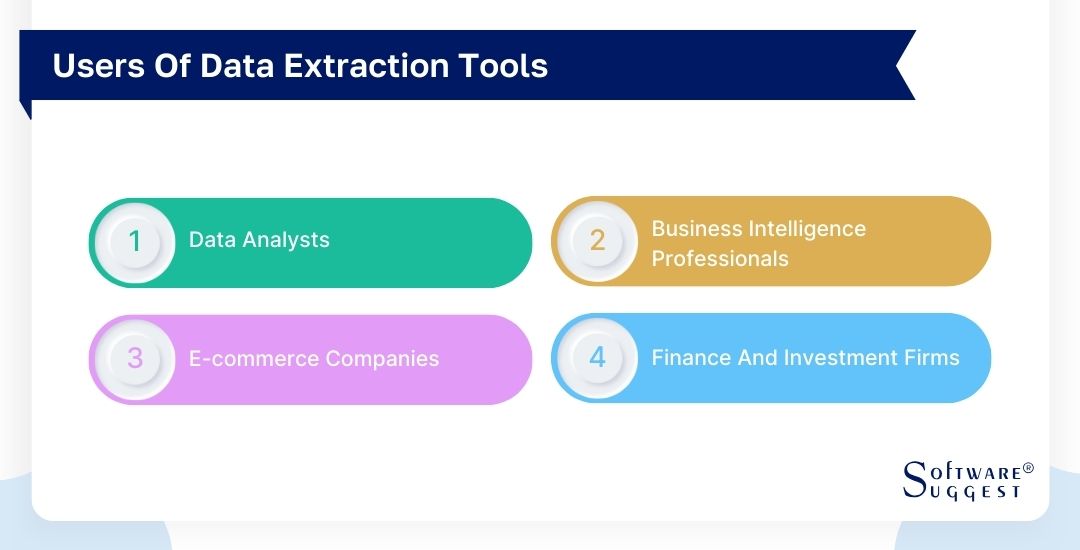
-
Data Analysts
Data analysts are one of the primary users of data extraction tools. They use these tools to pull data from varied sources as per their business needs, clean it, and structure it for future analysis. The insights drawn from this structured data help organizations make data-driven decisions and forecast future scenarios.
-
Business Intelligence Professionals
BI professionals are extensively involved in data-driven decision-making processes. Data extraction software is essential for them to collect, analyze, and interpret large volumes of data.
They use database extraction tools to pull out data from different sources like databases, data warehouses and also use tools to extract data from social media and public records.
This data is then processed and presented in an easy-to-understand, visual format such as dashboards, charts, or reports. This allows organizations to identify patterns, correlations, and trends, ultimately leading to improved business strategies and more informed decisions.
For professionals involved in roles requiring efficient data extraction and management, exploring various database management systems is recommended to identify the one most aligned with their specific needs.
-
E-commerce Companies
Data extraction tools are indispensable for e-commerce businesses.
These tools scrape product information, prices, reviews, and competitor data from various websites. This information helps e-commerce businesses in competitive pricing, improving product offerings, managing inventory based on customer preferences, and crafting effective marketing strategies.Moreover, this information extraction software can also be used to collect and analyze customer behavior data by companies, which can further help e-commerce brands to drive personalized shopping experiences and improve customer satisfaction and loyalty.
-
Finance & Investment Firms
These organizations deal with large volumes of data, including market trends, historical data, company profiles, financial reports, and more. Data extraction software allows them to gather this data quickly and efficiently from various online sources; also, they use database extraction tools to extract data from their already-made databases and financial portals.
The extracted data can then be analyzed to make investment decisions, predict market trends, evaluate risks, and determine the financial health of companies. In addition, these tools can also be used for regulatory compliance.
Types of Data Extraction Software
Since data comes in many different forms, & hence these tools are designed to extract particular data from sources. Some may have the functionality to extract data from the database only, while others may extract image data from multiple sources. This section compiles a list of different types of data extraction software.
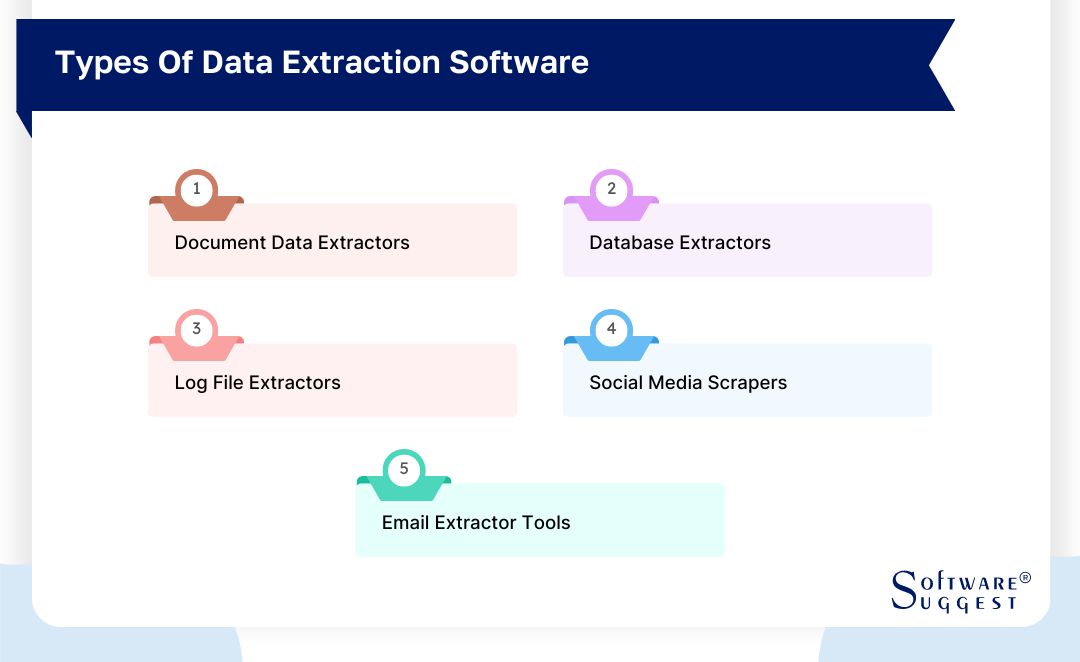
-
Document Data Extractors
These tools are primarily designed to extract data from various types of documents, including PDFs, Word documents, Excel spreadsheets, text files, and more & hence they are known as document data extractor tools.
This is particularly useful for organizations that handle large volumes of documents and need to retrieve specific information from them quickly and accurately.
Document data extraction software uses techniques like Optical Character Recognition (OCR) to convert different types of document files into machine-readable formats. Advanced versions of these tools can also identify and categorize data into predefined fields.
These tools help organizations save time and effort on manual data entry, minimize errors, and ensure the accuracy of the extracted data. Leading to improved efficiency in data management and allowing for more informed decision-making.
To fully capitalize on the benefits of these tools, consider utilizing data management software. These platforms can further streamline handling the data extracted from documents, helping your organization maintain data integrity and accuracy.
-
Database Extractors
Database extractors are designed to retrieve data from databases efficiently. These tools connect directly to database management systems such as MySQL, Oracle, SQL Server, etc. They can pull out data based on specific queries, allowing for precise data extraction according to the needs of the organization.
Database extraction tools can handle structured and unstructured documents, navigating complex relationships and hierarchies within the database. They often include features that support the transformation of data into a format that can be easily analyzed and understood. This data extraction process might involve cleaning the data, handling missing values, or converting data types.
A crucial feature of many database extractors is their ability to automate the extraction process. They can be scheduled to perform extraction tasks at regular intervals, ensuring that the data is always up-to-date. This is particularly useful for businesses that rely on real-time or near-real-time data to make decisions.
-
Log File Extractors
Log files are routinely generated by various systems and applications within an organization, including servers, networks, and security systems. These files can contain valuable data about system performance, user activity, and potential security threats, among other things. However, they often come in large volumes and are not structured for easy analysis.
Log file extractors are designed to address this challenge. These tools can parse log files of different formats, from simple text files to more complex XML or JSON files.
They can extract specific pieces of data from these files, such as timestamps, IP addresses, error messages, or any other information that might be relevant to the organization. In addition to simple extraction, many log file extractors also provide functionality for transforming and loading the extracted data.
This could involve aggregating data from multiple log files, converting data into a common format, or loading it into a database or data analysis tool.
-
Social Media Scrapers
As the name suggests, social media scrapers are specialized tools designed to extract data from various social media platforms like Facebook, Twitter, Instagram, LinkedIn, and more. With the vast amount of data generated on social media every second, these tools provide a way for businesses to tap into these rich sources of data & help easily extract data.
The data that can be extracted include posts, comments, likes, shares, followers, and more. Advanced tools can even capture metadata, such as the time of posting and geolocation information. They can also handle different content types, including text, images, and videos.
One of the most common applications of social media scrapers is sentiment analysis, where businesses use these tools to understand public opinion about their brand, products, or services. By extracting and analyzing social media posts and comments, businesses can gain insights into customer satisfaction, trending topics, potential issues, and more.
These tools come under many categories, including no-code web scrapers and in the form of APIs too.
-
Email Extractor Tools
Email extractors can be used to extract emails from a specific web source. Their use case lies in lead generation and customer relationship management. Businesses use these extractors to pull contact credentials and build customer and prospect databases.
To effectively manage and utilize this extracted contact data, you may want to consider investing in customer database software. This type of software can assist in organizing, managing, and analyzing the extracted customer information, thereby turning the raw data into actionable insights.
Features of Best Data Extraction Software
Choosing the ideal data extraction software involves understanding its features and aligning them with your business needs. These tools vary widely in their specializations - some excel at scraping web data, while others are made for pulling information from databases, documents, or social media.
Key functionalities to consider include automatic scheduling, real-time extraction, ease of use, and integration capabilities with other software such as a customer data platform.
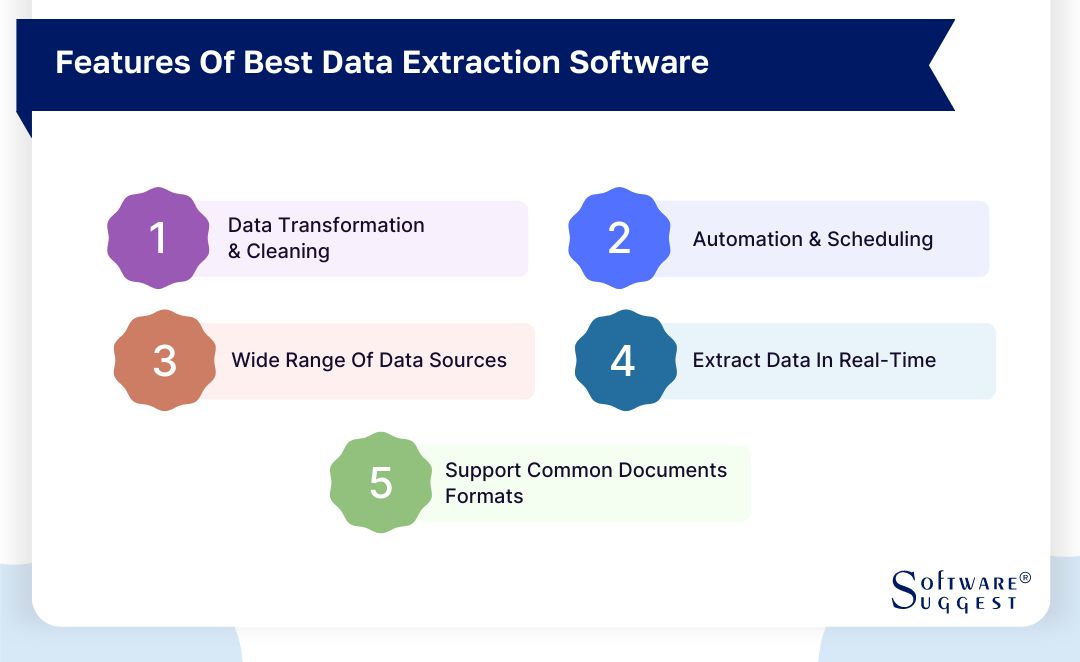
-
Data Transformation & Cleaning
Data transformation is the process of converting data from one format or structure into another. This might involve changing data types, aggregating data, or reorganizing data fields. It helps ensure that the extracted data aligns with the format and structure of your existing systems or datasets, making it easier to integrate and analyze.
Data cleaning, on the other hand, involves identifying and correcting errors in the data, such as duplicates, misspellings, or missing values. A good data extraction tool should provide functionalities for detecting and fixing such issues automatically or with minimal manual intervention.
This feature can significantly streamline your data extraction process. Tools that lack this feature may require you to manually perform these tasks, which will ultimately burden up your time and resources. To visualize and analyze your cleaned and transformed data, consider exploring data visualization tools that can help you to make sense of your datasets more efficiently.
-
Automation & Scheduling
Automation is another crucial feature that you should consider when choosing data extraction software. An effective solution should streamline the process of repetitive extraction tasks, thus freeing up your time and resources for more strategic activities.
The capability of an automated data extraction tool can be as simple as scheduling data extraction at specific intervals, such as daily, weekly, or monthly. It can also include more sophisticated processes, like triggering data extraction based on specific events or conditions.
Incorporating automation into your data extraction strategy allows for consistent data collection without the need for continuous manual effort. This feature is especially useful when working with large, frequently updated datasets, as it ensures that your information is always current and readily available when you need it.
Therefore, when evaluating a data extraction tool, it's essential to consider how effectively it can automate and schedule extractions according to your specific data requirements.
-
Wide Range of Data Sources
A tool with broad source compatibility can provide more comprehensive insights by gathering data from diverse areas. This feature can be especially beneficial when you need to aggregate data from different sources.
Moreover, even if you currently extract data from only one or a few sources, having the option to expand your data sources in the future can provide flexibility and scalability as your business and data needs evolve.
Hence it is a bonus to have your tool extract data from a wide range of sources. In addition, consider whether it can handle different types of data, including structured data, semi-structured data, and unstructured data.
-
Extract Data in Real-Time
For businesses to be able to make faster and smarter decisions, they need to have access to data on time. However, many organizations rely on batch data extraction. That means while analyzing, the information might not be up-to-date and have to make critical decisions based on historical data.
Thus, an effective data extraction solution must be capable of collecting and analyzing data in real-time. For instance, you would need data on the current inventory level if you want to conduct a sale.
-
Support Common Documents Formats
Organizations collect data from multiple sources that are in structured, semi-structured, or unstructured formats. Structured formats are easy to process and analyze. However, the main problems lie with the unstructured data. An ideal tool should be able to extract data from various common unstructured formats, including pdf, txt, Docx, doc, rtf, and more so that businesses can gather as much data as possible.
Benefits of Best Data Extraction Tools
With the right data extraction tool, businesses not only automate the process of data collection but also save time and cost. Moreover, these tools can consistently provide data that is accurate and consistent. To be a successful business, it is an invaluable asset for any business to get these characteristics of data.
In this section, we'll talk about the key benefits that data extraction software can provide.

-
Advanced-Data Analysis
One of the key benefits of using top-tier data extraction software is its potential to make your team do advanced data analysis. Whether it's predicting future trends, identifying areas for improvement, or making strategic business decisions, having reliable and comprehensive data is crucial.
Moreover, some data extraction tools offer built-in data analysis capabilities allowing you to visualize and analyze as soon as the data is extracted in the tool itself. This allows you to further save time in transferring this data to a separate analytics platform.
-
Streamlined Workflows
The other advantage of incorporating a data extraction tool is streamlined workflows. So not every time you have to worry about the data you need to extract from sources. By automation the data extraction process, these tools eliminate the need for manual data collection and manipulation, which can be hectic and error-prone.
Also, some data extraction tools are designed to seamlessly integrate with other software in your tech stack, thus helping you to streamline your workflows.
-
Better Analysis and Fast Decision Making
The role of effective data extraction software is not limited to only collecting data. But it can also extract meaningful insights from unstructured data and help businesses make informed decisions.
-
Increases Productivity
Data extraction software streamlines and automates the process of collecting and storing data, which eliminates the need to manually process it. This directly impacts the productivity level of your employees. It removes repetitive data collection tasks, and they get more time to focus on core activities. Thus, it increases the company’s chances of success.
-
Helps Extract Search Result Data for Competitor Analysis
To rank on top of the search result page, you need to keep an eye on your competitors’ activities. Data extraction software pulls out data such as metadata, keyword tags, backlinks, and more from your competitors’ websites. You can then use this data to run competitors’ analysis to know which keyword drives the traffic towards them and what kind of content is giving them engagement.
-
Enhances Accuracy
When employees extract data from documents or other sources manually, it is prone to error. It can result in incomplete records, duplication, or missing information. Such mistakes can be easily avoided by automating the whole process of data mining. Data mining is important because it not only saves time and effort but also ensures data accuracy.
How To Choose The Right Automated Data Extraction Tool?
When evaluating different data extraction tools, it's crucial to consider their features and how well they align with your data strategy. Some may offer a broad range of functionalities but may not be as useful if you need to perform simple data extractions.
On the other hand, some tools may seem affordable and easy to use, but they may not provide the capabilities you are looking for in data extraction tools for your business to evolve and grow.
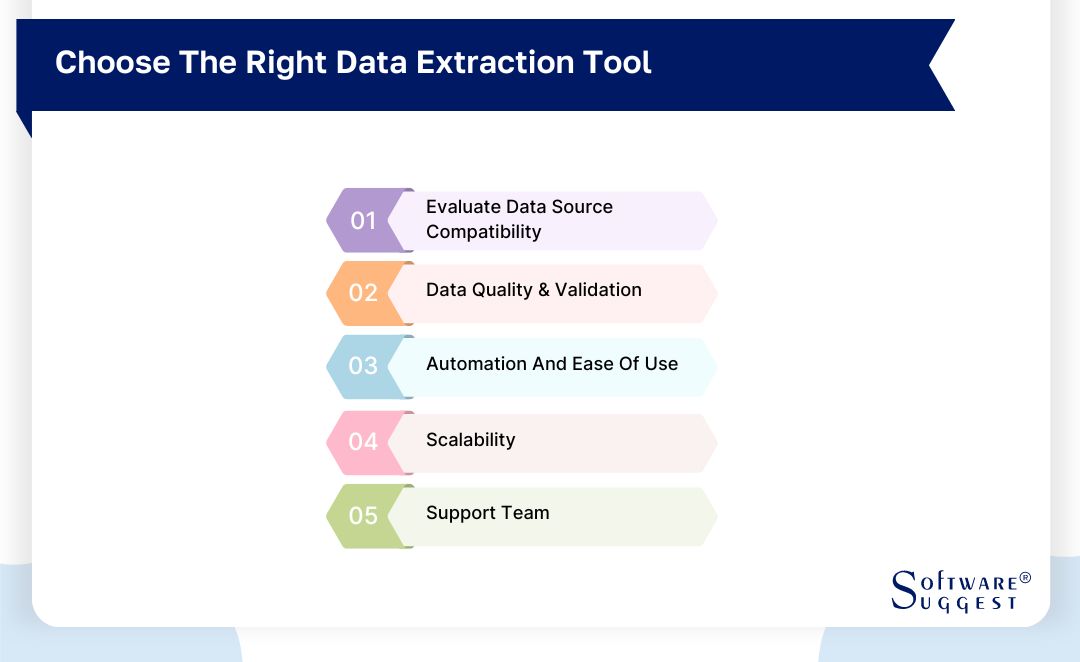
-
Evaluate Data Source Compatibility
One of the first and most critical considerations when choosing an automated data extraction tool is its extraction capabilities with your desired data sources. Not all tools are created equal, and some may be restricted or entirely blocked by certain platforms that prevent data scraping.
For example, certain websites or platforms have robust anti-scraping measures in place to protect their data. If you need data from these sources and your chosen tool cannot bypass these protections, it will be of limited value to your data extraction needs.
Hence, before fully committing to a tool, it's crucial to test its capabilities thoroughly. Ensure it can seamlessly extract data from all necessary sources, even those with stringent anti-scraping measures. A trial or testing period can be extremely beneficial in this regard, allowing you to evaluate the tool's effectiveness before implementing it at full scale.
-
Data Quality & Validation
Ensuring the quality of the extracted data is another vital factor to consider when selecting an automated data extraction tool. High-quality data is accurate, complete, timely, and relevant, all necessary for reliable analysis and decision-making.
Automated extraction tools should ideally have built-in data validation features to check and ensure the quality of the extracted data. For example, the tool might cross-check the extracted data with different sources, use algorithms to detect inconsistencies or errors, or automatically clean and standardize the data to a particular format.
In addition, the tool should be capable of dealing with incomplete or inconsistent data. This could involve flagging incomplete records for further review or using advanced techniques to fill in gaps in the data.
-
Automation and Ease of Use
While the primary purpose of an automated data extraction tool is to streamline the data collection process, it should also be easy to use. An intuitive user interface and straightforward functionalities can greatly enhance the user experience, reducing the time required to learn and operate the tool.
Automated data extraction tools should offer features like scheduling, which can enable the tool to run extractions at predetermined intervals without manual intervention.
This level of automation saves time and ensures consistent and regular data collection. However, automation should not come at the cost of flexibility. The tool should still allow for customization according to your specific extraction needs. For example, you should be able to specify what data to extract, from which sources, and in what format the extracted data should be.
Finally, consider the level of technical expertise required to operate the tool. While some tools may require significant technical knowledge, others are designed with non-technical users in mind. Depending on your team's skill set, you might prefer a tool with a more user-friendly design or one that provides robust customer support and training.
-
Scalability
Whether you are a small or a big corporation, eventually, your data requirement is going to increase. That’s why it is ideal for deploying your software on a cloud service so that you can scale up without having to invest in a lot of hardware. Besides, software-as-a-service is easy and quick to make updates at a relatively low cost compared to traditional legacy systems.
-
Support Team
Once you have implemented the system, there are chances that you might face some technical issues or the system might crash anytime. In such situations, you need immediate assistance from your vendors. That’s why they always stop to check if they have a reliable and active customer support team in place. Otherwise, any disruption in the system that is not fixed quickly can hamper your business operation.
List of Top 5 Data Extraction Tools Comparison
|
Name
|
Free Trial
|
Demo
|
Pricing
|
|---|---|---|---|
|
14 Days |
Yes |
Starting price at $249 to $999/month |
|
|
7 Days |
Yes |
Starting price at $0.80/IP + $0.110/GB |
|
|
7 Days |
Yes |
Starting price at $50/month |
|
|
14 Days |
Yes |
Starting price at $199/month with 5000 queries |
|
|
7 Days |
Yes |
Starting price at $75/month |
We will be looking at some of the top data extraction software which is currently dominating this data extraction domain. For each tool, we will provide you with key features, its pros, cons as well as pricing. This overview will help you access the best one for your needs.
1. Hevo Data
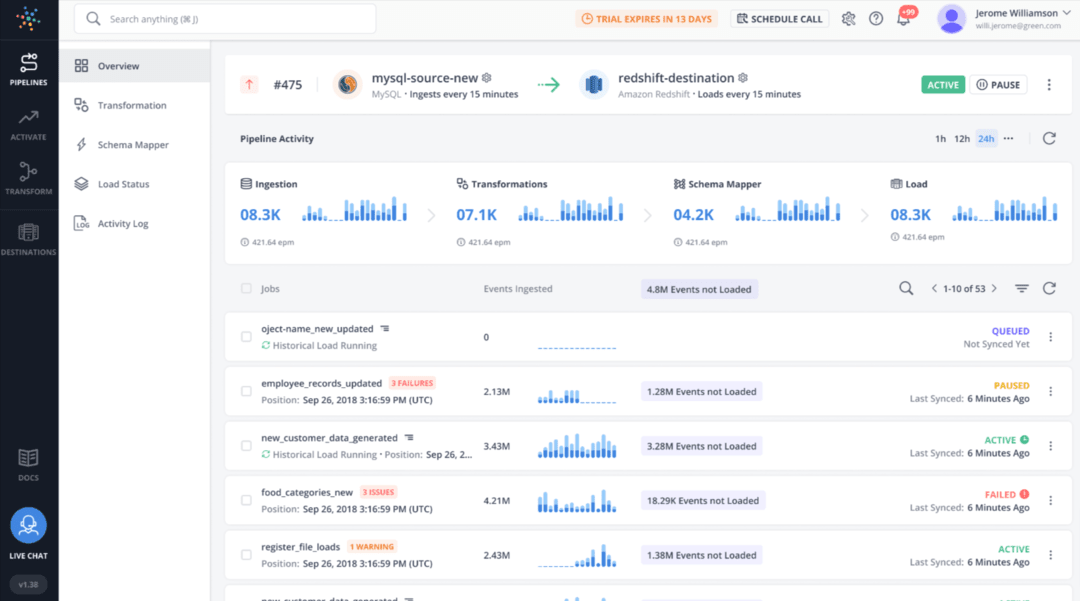
Hevo Data is a data pipeline platform that automatically syncs data from over 150 data sources, including SQL, NoSQL, and SaaS applications, to your warehouse and transforms it for analytics. This helps to free up data teams from managing data extraction and managing data pipelines.
- Multiple workspaces within a domain
- Multi-region support
- ELT pipelines with In-flight data formatting capability
- Reverse ETL solution
- Draft pipelines
- Historical data sync
- Flexible data replication options
- Sync from one or multiple databases
- Data deduplication
- Load new tables with the same pipeline
- Smart assist
- On-demand credit
- On-demand usage
- Easy configuration and set-up with just a few clicks
- Excellent customer service team with friendly members
- Possibility to set up ETL without any coding skills
- Seamless data integration experience
- It lacks the option to schedule pipeline jobs at specific times.
- Transformations can be a bit confusing.
- Users have reported high CPU usage.
- The platform may be challenging to navigate initially.
Pricing
- Free: This plan gives you unlimited data sources and models. Support is given via email, a single sign-on, and unlimited user seats. It has limited functionalities and is great for testing purposes.
- Starter: Starts from $249 to $999 per month, depending on the number of events you want. Events start from 20 million to 300 million. Get live chat support as well as email support. Get setup assistance too with this plan.
- Business: Customizable pricing solution for companies with heavy requirements.
2. Brightdata
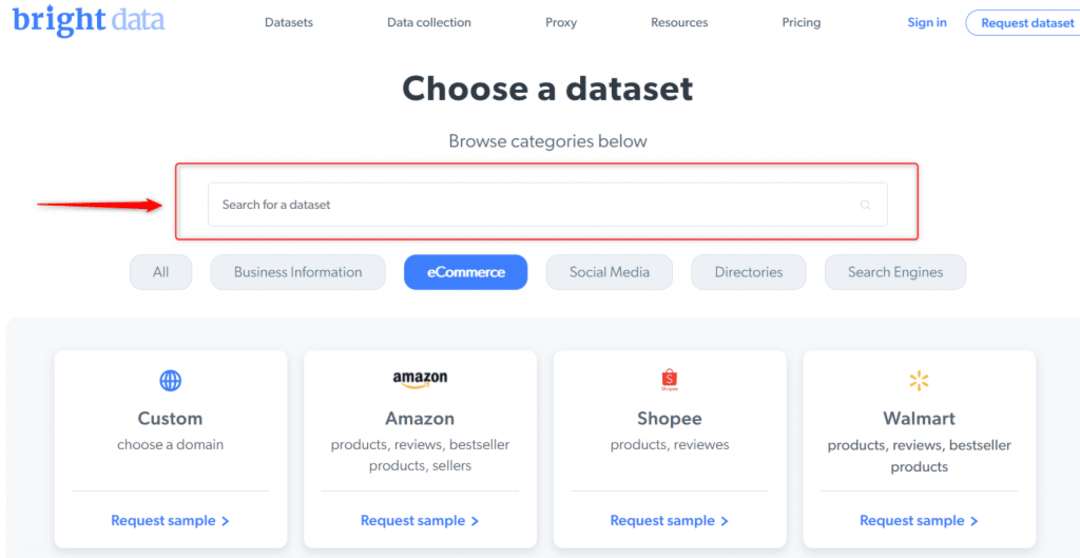
Brightdata is one of the industry's largest proxy provider solutions. It is widely known for its reliable and quality proxies and web unlocker tools for bypassing website blockages and extracting public web data. Using millions of rotating IPs from various countries, Brightdata enables its users to perform web scraping at scale.
- Image extraction
- Document extraction
- Email address extraction
- Phone number extraction
- Pricing extraction
- Web data extraction
- IP address extraction
- Offers speedy and dependable proxy services.
- Provides immediate access to public web data.
- Features a potent web unlocker tool.
- Presents versatile proxy utilities.
- Not the cheapest provider online.
- There can be more pricing bills to fit customer needs.
Pricing
a) Pay-As-You-Go
This plan does not require any monthly or yearly commitment and only charges you for the proxies that you use. Here are the current rates for each proxy type offered by Bright Data:
- Data center proxies: $0.80/IP + $0.110/GB
- ISP proxies: $0.50/IP + $15.00/GB
- Mobile proxies: $40.00/GB
- Residential proxies: $15.00/GB
b) Starter
- The starter plan costs $500/month. This plan is inclusive of data center, residential, ISP, and Mobile proxies, the user chooses a proxy in this plan.
c) Advanced
- This plan costs $1000/month and the user can use any proxy in it. It is best for medium to large corporations.
d) Enterprise
- This is a customized plan for bigger requirements from the companies. This plan includes unlimited scaling options, data experts support, a free proxy manager, and a premium SLA.
3. Webscraper.io
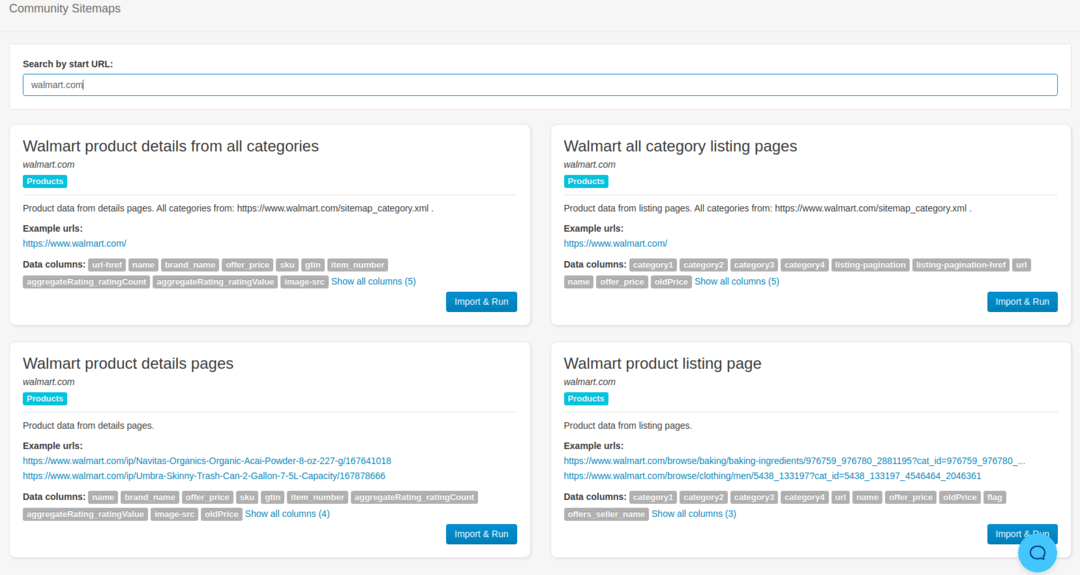
WebScraper.io is a robust, cloud-based data extraction tool that provides solutions for scraping and extracting data from websites. This tool is versatile and user-friendly, making it suitable for both beginners and seasoned professionals. It allows you to navigate through web pages using the Chrome browser and extract data in a wide array of formats such as CSV, Excel, or JSON files.
- Data extraction
- Scrapes multiple pages
- Schedules scraping tasks
- Export to CSV/Excel
- Customizable selectors
- JavaScript support
- Facilitates user-friendly, point-and-click setup.
- Strong performance with the ability to handle large-scale data extraction.
- Offers comprehensive tutorial resources, aiding the user journey.
- The interface might feel complex for beginners.
- Extraction speed can be slow, depending on server capacity.
- Does not provide built-in storage or analysis options; extracted data needs to be managed separately.
Pricing
- Free: This is a basic tier with limited features, suitable for beginners or those with minimal data extraction needs.
- Personal Plan: This is priced around $50 per month and includes features like unlimited scraping, access to premium servers, faster execution times, and priority customer support.
- Professional Plan: This plan costs around $100 per month and adds features such as concurrent scraping jobs, higher server capacity, and priority in the job queue.
- Business Plan: This is the highest tier, priced at around $250 per month, and is designed for high-volume data extraction needs. It provides benefits like exclusive servers, high concurrency, dedicated support, and more.
- Scale: Starts from $300 & is more of an enterprise plan to scale up your data extraction process.
4. Import.io
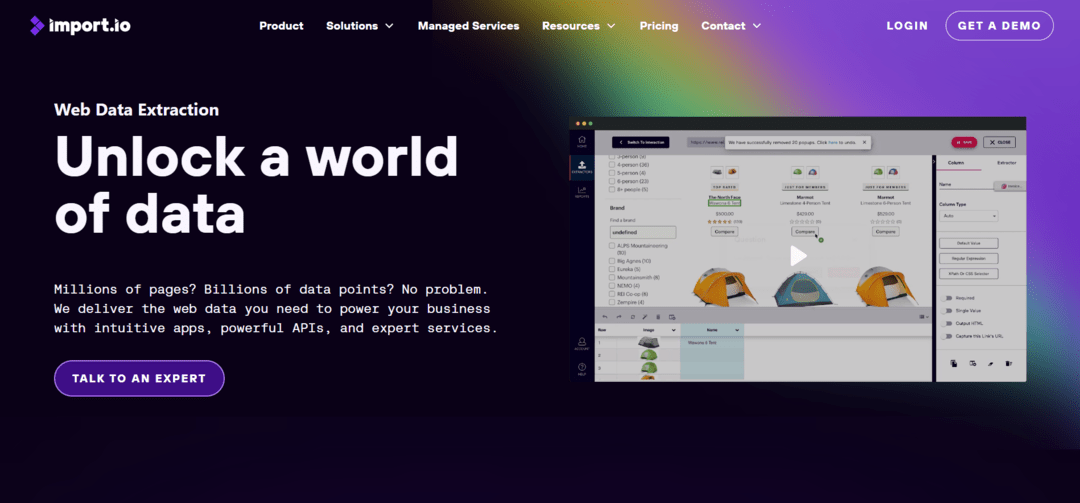
Import.io is a platform that enables the conversion of semi-structured information in web pages into structured data. They offer real-time data retrieval through JSON Rest-based and streaming APIs and integrate with many common programming languages & data analysis tools.
- Automated data extraction
- Highly scalable
- Top-notch data quality
- Advanced-data exporting
- Integration capabilities
- User-friendly, simplifying the data extraction process.
- Robust automation features streamline various tasks.
- Supports a wide array of data sources.
- Excellent customer support for issue resolution.
- Primarily focused on web data extraction, limiting its versatility.
- Initial steep learning curve may challenge new users.
Pricing
- Starter-Starts at $199/month with 5000 queries. Features like point-and-click selection & training, image downloads, scheduler, and email notifications.
- Standard- At $599/month, including all the features in the starter plan + Interactive extractors, premium proxies, and country-specific Extractors.
- Advanced - Starts at $1099/month; this plan is built for extracting data at scale, with support levels for the most critical use cases. Has all the features of the standard plan with queries up to 50,000. You also get phone support in this plan.
5. Octoparse
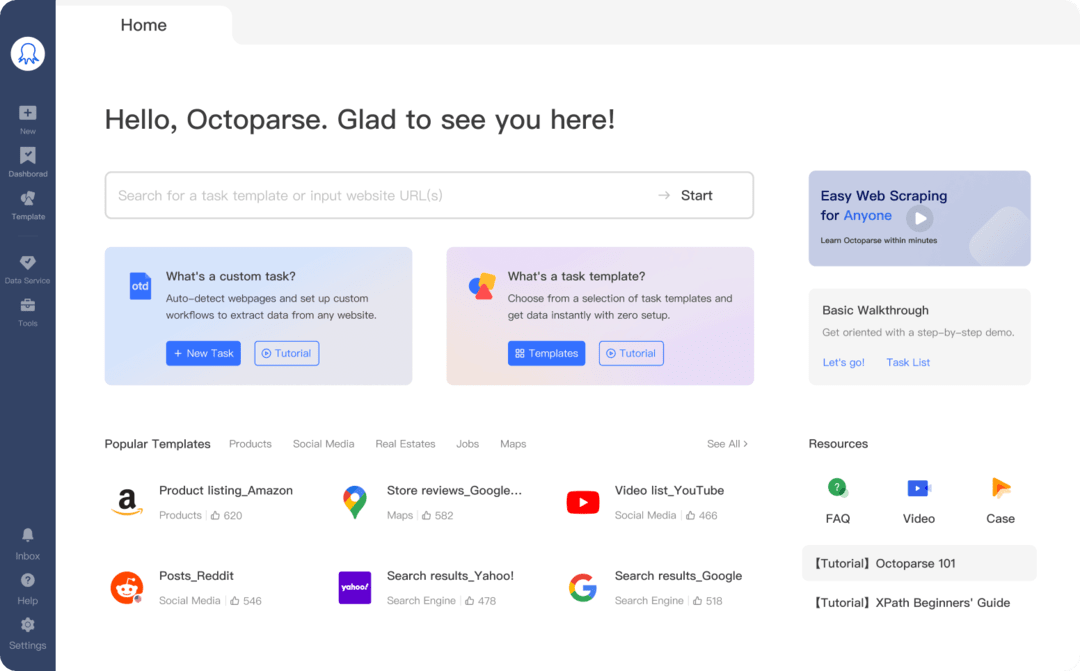
Octoparse is a cloud-based web data extraction solution that helps users extract relevant information from various types of websites. It is a no-coding solution for web scraping to turn web pages into structured data.
Apart from its core features, Octoparse also supports different export formats, providing users with the flexibility to utilize the extracted data in the most convenient way for their specific needs. With a blend of user-friendly design and robust performance, Octoparse has become a favored choice among many who seek efficient web data extraction solutions.
- Web Scraping capabilities
- Point-and-click interface
- Automatic IP rotation
- Schedule & automate
- Data export options
- Offers a user-friendly interface that eases the extraction process.
- Provides strong customer support to aid with queries and issues.
- Demonstrates adaptability in handling various data types and export formats.
- Delivers high performance, particularly with cloud-based extraction and IP rotation.
- Limited capabilities for handling complex website structures.
- May occasionally struggle with website changes or updates.
Pricing
- Free: Allows up to 10 tasks, users can run tasks on local devices only.
- Standard Plan: Priced at $75/month, it offers unlimited pages per crawl and up to 6 cloud servers.
- Professional Plan: Priced at $209/month, it provides more cloud servers, higher concurrency, and faster data extraction speed.
Challenges of Data Extraction Solution
Implementing and using data extraction solutions involves navigating a landscape filled with potential pitfalls, and a clear understanding of these challenges is crucial to ensure effective and efficient data extraction.
The following points take deep into some of the key challenges users may face while using data extraction solutions.
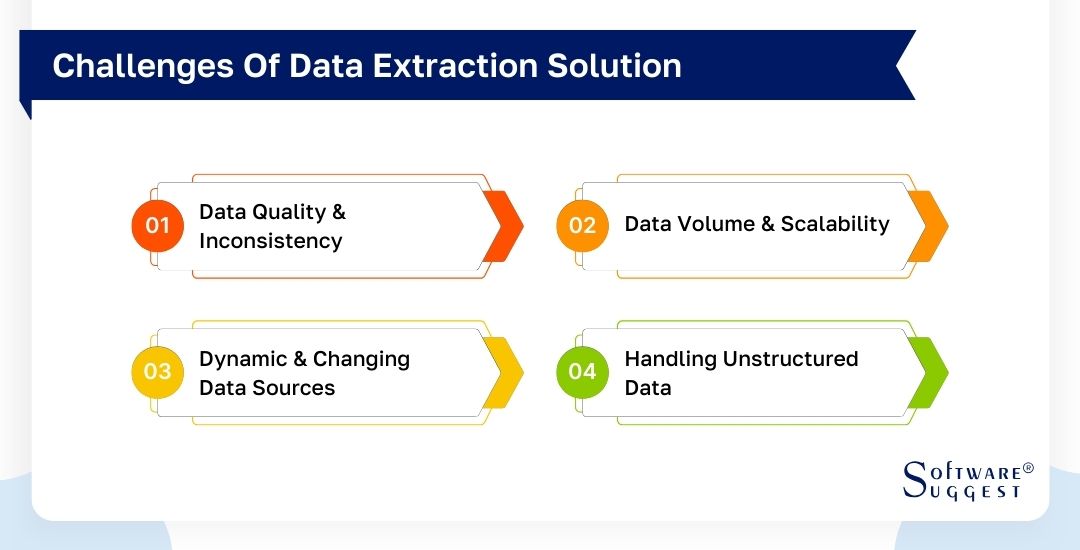
-
Data Quality & Inconsistency
Data quality refers to the data's accuracy, completeness, and relevance, while consistency pertains to the uniformity of the data format across different sources. Data extracted from various sources can be inconsistent in structure, format, and quality. Poor data quality can lead to incorrect analysis, faulty insights, and ultimately, wrong business decisions.
Similarly, inconsistent data can make it difficult to aggregate and analyze data, thereby reducing its usability. Thus, it's crucial to have robust data validation and cleaning mechanisms in place when using data extraction tools.
Consider tools that offer features for handling data inconsistencies, like data transformation and normalization capabilities, and those that ensure the data remains up-to-date by regularly refreshing the extracted data.
-
Data Volume & Scalability
The sheer volume of data available online today poses another significant challenge. As businesses grow, their data needs often expand, requiring increasingly large amounts of data extraction.
This demands data extraction solutions that can scale efficiently and handle high volumes of data without performance degradation.
Not all data extraction tools are built to handle massive volumes of data, and some might struggle or become slow when faced with large-scale extraction tasks.
It's important, therefore, to consider the scalability of a tool when selecting a data extraction solution.
-
Dynamic & Changing Data Sources
Changes in the structure or layout of a website can break the data extraction process. Data extraction tools typically rely on the specific structure of a website to locate and extract the desired data.
If this structure changes, the tool may no longer be able to find the data or it might extract incorrect data.
Secondly, online platforms frequently update their data access policies, which can restrict how and what data can be extracted. This means that a tool that was able to extract certain data today might not be able to do so tomorrow.
Hence, the tool should be flexible to adjust to the dynamic structure of the source to extract data seamlessly from it. -
Handling Unstructured Data
Unstructured data forms the majority of online data and holds valuable insights. However, extracting and processing this data can be difficult due to its lack of structure.
Traditional data extraction methods might not work effectively on unstructured data.
Data extraction tools need advanced capabilities, such as Natural Language Processing (NLP) and image recognition, to handle unstructured data effectively.
Therefore, when choosing a data extraction solution, consider whether it has the capability to process unstructured data in addition to structured data.
Latest Trends in Data Extraction Software
Latest trends shape the trajectory of technological advancements in this space and redefine how businesses handle and utilize their data. The following points outline some of the most influential trends in data extraction software today.
Let's understand the evolving data extraction landscape.
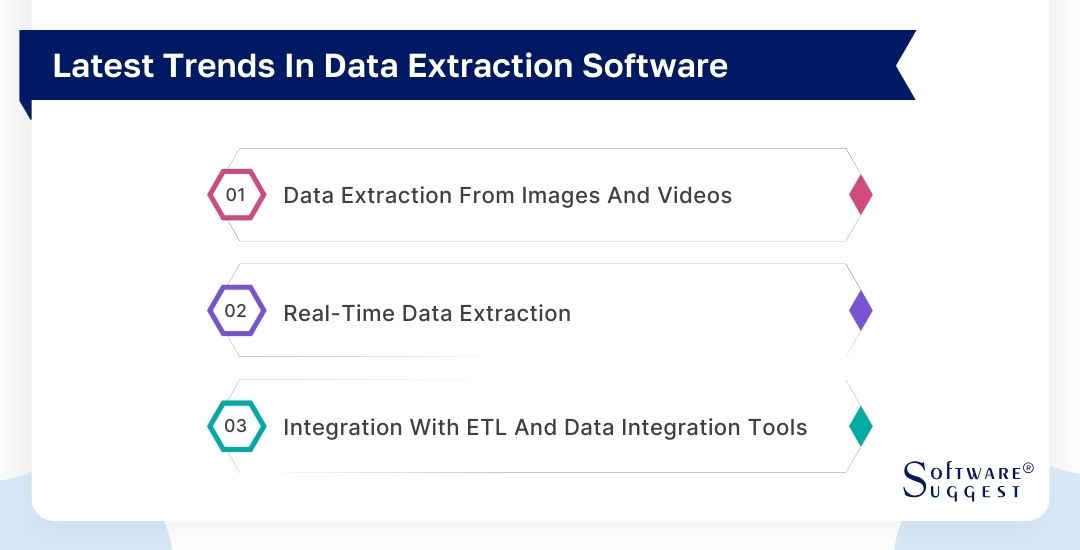
-
Data Extraction from Images and Videos
The rise of visual content in the digital realm cannot be understated, with its influence projected to keep growing in the foreseeable future. As this type of content proliferates, the demand for extracting significant insights from such visual assets intensifies.
Data extraction from images and videos, once considered a complex and daunting task, has been made achievable thanks to technological advancements.
Key innovations, such as image recognition, optical character recognition (OCR), and machine learning algorithms, are driving this change, enabling the transformation of visual data into analyzable and actionable information.
As we navigate through this evolving digital landscape, it is anticipated that the demand for tools capable of extracting data from images and videos will surge.
Users will increasingly seek solutions that can accurately decipher the information embedded in these visual resources and seamlessly integrate these insights into their data analysis workflows.
This development, fuelled by the continued growth of visual content, is poised to redefine the scope and capabilities of data extraction tools, making them an indispensable asset in our increasingly data-driven world.
-
Real-Time Data Extraction
The introduction of real-time data extraction is an increasing shift in the data extraction sector. Simply put, this process involves immediate data collection as it becomes available.
This is an invaluable feature for businesses that operate on swift, data-backed decision-making. Immediate access to and analysis of data enables organizations to react and adapt to changes in the market instantaneously.
This aspect is incredibly beneficial in sectors where market fluctuations occur rapidly, necessitating prompt and adaptable strategies.
As data persists as a crucial element in steering business choices, the need for real-time data extraction will likely intensify. This trend represents a significant evolution in how businesses harness the power of data extraction tools in our digitized world.
-
Integration with ETL and Data Integration Tools
This shift is a direct answer to the demand for more efficient and streamlined data processing workflows.
In the data pipeline, ETL tools play an instrumental role. They enable data to be extracted from a wide array of sources, transformed to suit the needs of operational processes, and then loaded into the final destination for further analysis.
Given that data extraction lays the foundation for this process, integrating it with ETL tools can greatly enhance the overall effectiveness and efficiency of data processing.
In addition, the integration of data extraction software with other data integration platforms facilitates a smoother data transfer, superior management of data quality, and optimized workflow automation.
As enterprises increasingly bank on data-fueled insights, the fusion of data extraction with ETL and data integration tools is set to become even more critical.
Conclusion
Data extraction software plays a pivotal role in today's data-driven business environment, helping organizations unlock valuable insights from a wide variety of data sources. While choosing the right tool can be challenging given that there are a lot of factors to consider, understanding your business needs, the tool's features, scalability, and adaptability to changing data sources can make the process more manageable.
Keeping abreast of the latest trends, such as real-time data extraction, data extraction from images and videos, and the integration with ETL and data integration tools, can help businesses stay competitive and make the most of their data extraction endeavors.
Moving forward, we expect the field of data extraction to continue evolving, with more advanced and sophisticated tools emerging. Therefore, businesses need to stay adaptable, continuously reassess their data extraction strategies, and always be on the lookout for solutions that can offer them the edge in their respective markets.
Related Articles
FAQs
Luckily, yes. There are many free and open-source data extraction software options available. Free data extraction software ScrapeStorm, Parsehub, Tabula
Open-source data extraction software: Scrapy, WebHarvy, SPIDA
By Industries


_(1).png)


















